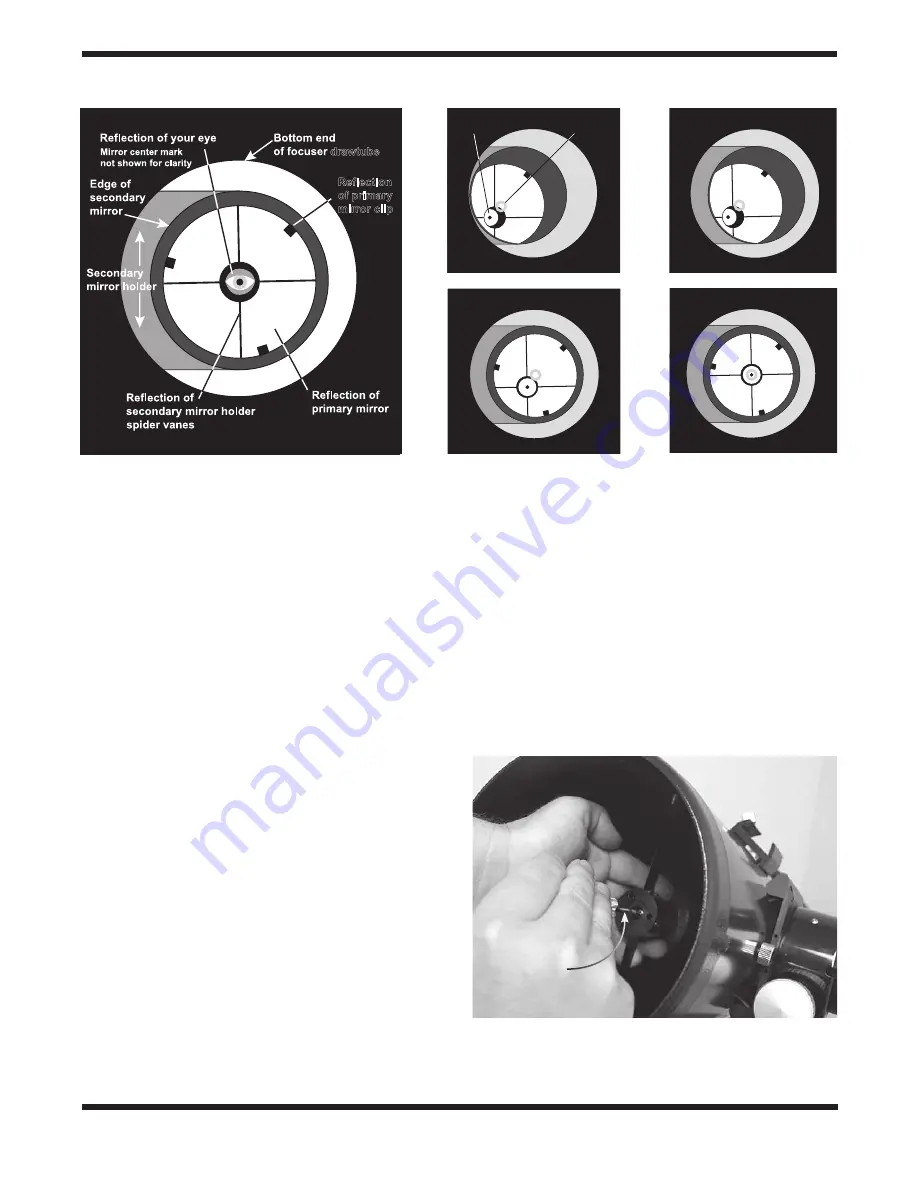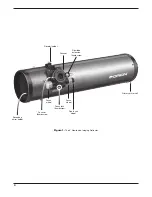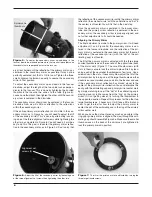
5
tom. This helps center your eye so collimating is easy to per
form. Figures 3b through 3e assume you have the collimating
cap in place.
In addition to the collimating cap, you’ll notice a small ring
label on the exact center of the primary mirror. This “center
mark” allows you to achieve a very precise alignment of the
primary mirror; you don’t have to guess where the center of
the mirror is. You simply adjust the primary mirror position
(described below) until the reflection of the hole in the col
limating cap is centered inside the ring.
Note: The center ring sticker need not ever be removed from
the primary mirror. Because it lies directly in the shadow of
the secondary mirror, its presence in no way adversely affects
the optical performance of the telescope or the image quality.
That might seem counter-intuitive, but it’s true!
Aligning the Secondary Mirror
It helps to adjust the secondary mirror in a brightly lit room with
the telescope pointed toward a bright surface, such as white
paper or wall. Placing a piece of white paper in the telescope
tube opposite the focuser (i.e. behind the secondary mirror)
will also be helpful in collimating the secondary mirror.
With the collimating cap in place, look through the hole in the
cap at the secondary (diagonal) mirror. Ignore the reflections
for the time being. The secondary mirror itself should be cen
tered in the focuser drawtube. If it isn’t, as in Figure 3b, it must
be adjusted. Typically, this adjustment will rarely, if ever, need
to be done.
Note: When make adjustments to the secondary mirror position,
be careful not to stress the spider vanes, or they may bend.
To adjust the secondary mirror lefttoright in the focuser
drawtube, use the included 2.5mm hex key to loosen the three
small alignment setscrews in the center hub of the 4vaned
spider several turns. Now hold the mirror holder stationary
(be careful not to touch the surface of the mirror), while turn
ing the center screw with a Phillips head screwdriver (Figure
4). Turning the screw clockwise will move the secondary mir
ror toward the front opening of the optical tube, while turning
the screw counterclockwise will move the secondary mirror
toward the primary mirror. When the secondary mirror is cen
tered lefttoright in the focuser drawtube, rotate the second
Figure 3.
Collimating the optics.
(a)
When the mirrors are properly aligned, the view down the focuser drawtube should look
like this.
(b)
With the collimation cap in place, if the optics are out of alignment, the view might look something like this.
(c)
Here, the secondary mirror is centered under the focuser, but it needs to be adjusted (tilted) so that the entire primary mirror
is visible.
(d)
The secondary mirror is correctly aligned, but the primary mirror still needs adjustment. When the primary mirror
is correctly aligned, the “dot” will be centered, as in
(e)
.
drawtube
Reflection
of primary
mirror clip
a.
Primary mirror
center mark
Reflective surface
of collimation
cap
b.
c.
d.
e.
Figure 4.
To center the secondary mirror under the focuser, hold
the secondary mirror holder in place with your fingers while adjusting
the center screw with the Phillips head screwdriver. Do not touch the
mirror’s surface.
Phillips head
screwdriver





















